Dr. Gerhard TOTSCHNIG, Dr. Demet SUNA
AIT Austrian Institute of Technology GmbH, Giefinggasse 2 1210 Vienna/Austria
T: +43 664 88335436, E-Mail: gerhard.totschnig@ait.ac.at, W: www.ait.ac.at
Introduction
Within the H2020 project REACT the potential for flexibly adapting the electricity consumption of typical residential buildings with air source heat pumps at Aran Islands is analysed: i.e: adapting the electricity consumption to hours where it is beneficial for the electricity system of the island. That means to consume power when it is available and cheap and to avoid consuming electricity when its supply is scarce and expensive. The results of this analysis show that on average 35% of the electricity demand could be shifted to times of energy abundance and 32% of the electricity costs could be saved. However, to be able to operate all systems in an economic manner, flexible end-user tariffs are needed, so that end-users can react to price signals.
Background and approach
The Aran Islands, a group of three small yet culturally significant isles off the west coast of Ireland, located in Galway Bay, are notable for their history, which stretches back thousands of years. Over 75% of the land area is designated as ‘Special Areas of Conservation’, where development is constrained. The topography is dominated by karst limestone, dry stone walling, and western/southern-facing cliffs. The islands are famous for their typical stone houses, highly exposed to prevailing winds from the west/south-west. The primary industry on the islands is tourism and the average population doubles during the summer months. The purpose of the analysis is to estimate the flexibility potential of typical residential buildings with air source heat pumps at Aran Islands if hourly variable electricity prices were available.
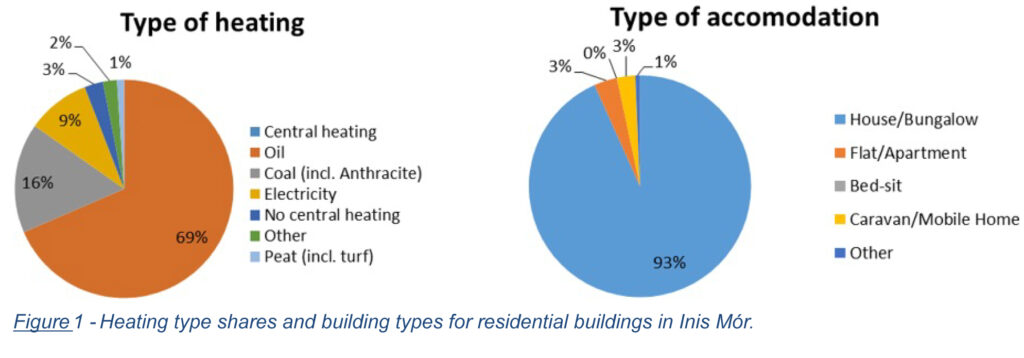
From Figure 1, one can see that almost all households on Inis Mór are in a family house/bungalow, there are not many apartments. 86% of the households are heated with fossil fuels (oil, coal, peat, see Figure 1). 50% of the houses were built before 1970 (see Table 1).
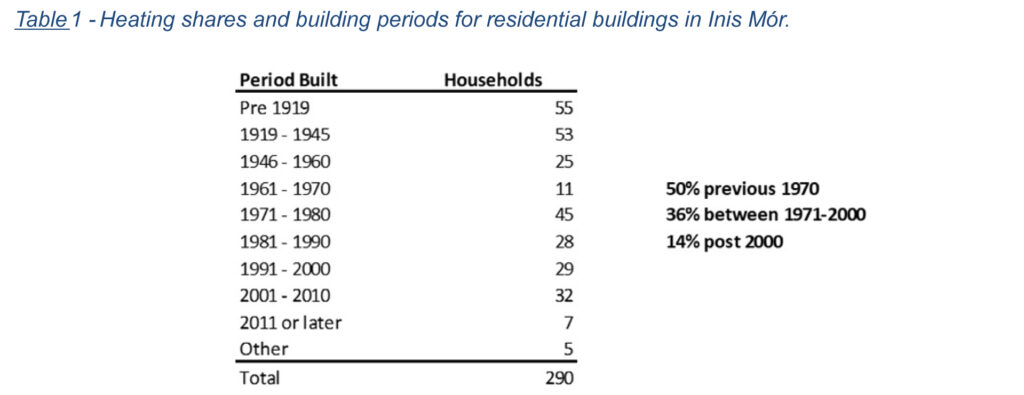
In a first step, key buildings and clusters were chosen (see Figure 2) based on a scoring system that involves various criteria such as technical, community, and economic issues.
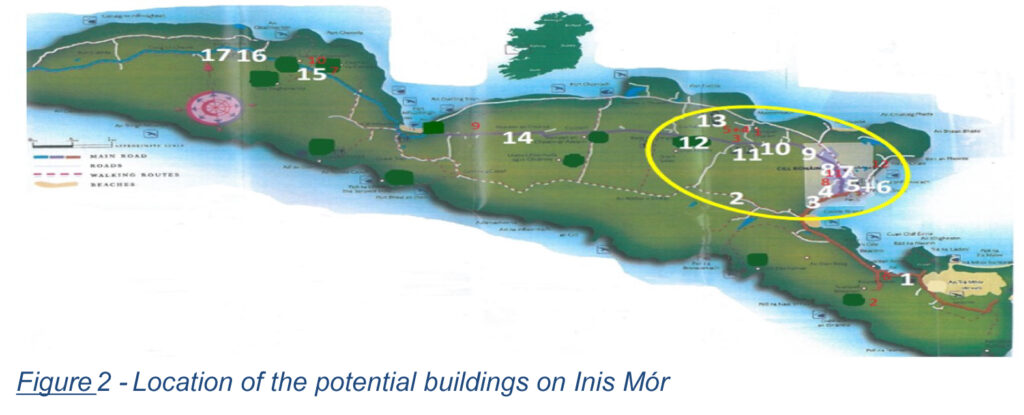
A planning tool and methodology
It is assumed the residential houses will receive an hourly variable electricity price as given by the Irish day-ahead spot market prices. Since the day-ahead electricity prices are fixed on the previous day, the electric heat pumps can be optimized in such a way as to consume electricity at hours with low cost.
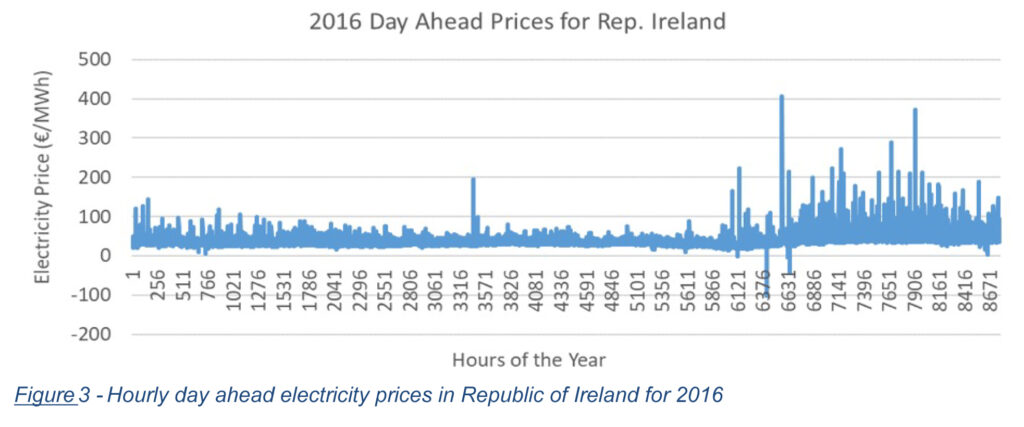
From Figure 3, one can see that in the Republic of Ireland there are strong daily electricity price variations. By operating the heat pumps according to market signals the households can save costs and contribute to a system-friendly behavior of electricity demand.
Variable time resolution model
For the analysis, a set of typical buildings, equipped with air source heat pumps and thermal storage tanks, was simulated. The average demand-side flexibility and cost savings of the heat pump buildings were analysed by developing an optimization model. For capturing the power requirements realistically, a model with variable time resolution was developed.
In times with hot water consumption, the model has a time resolution of 1 minute. In times without hot water consumption, the time resolution for heating and recharging the hot water tank is 1 hour. As a result, the year is optimized with 42.000-time steps. The basis of the model is a physical model of different residential buildings and their heating systems, describing their thermal properties, internal gains, solar gains, and heating losses. Solar radiation and temperature data[1] for Aran Islands for the year 2016 was used in the simulation.
Heat pump model
The performance of heat pumps depends strongly on the heat source temperature and the heat supply temperature. For the demo sites, air-source heat pumps are considered. They have rather low investment costs and can be standardized. The heat source is the ambient outdoor air, where heat is extracted. The coefficient of performance (COP) describes the thermal power delivered by the heat pump in the relation to the consumed electricity:
Thermal Output=Electrical Input * COP
For the demo site buildings, the heat extracted from the ambient air is converted by the heat pump to higher temperatures of hot water supplied to wall-mounted heating radiators. The heat pump performance factor COP strongly depends on the outside air temperature and the supply temperature for the radiators.
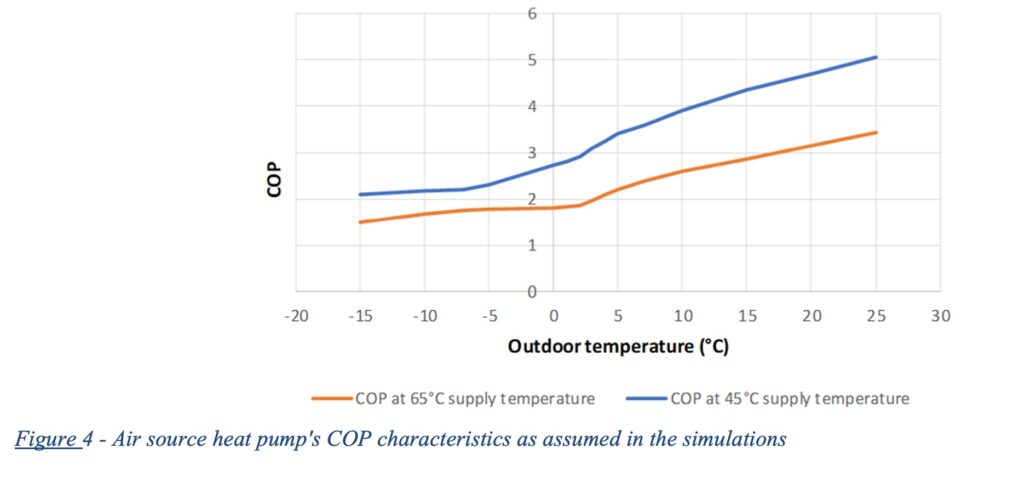
Air temperatures vary most of the time between 5 and 10 °C in the winter (see Figure 5). That is a good environment for air source heat pumps.
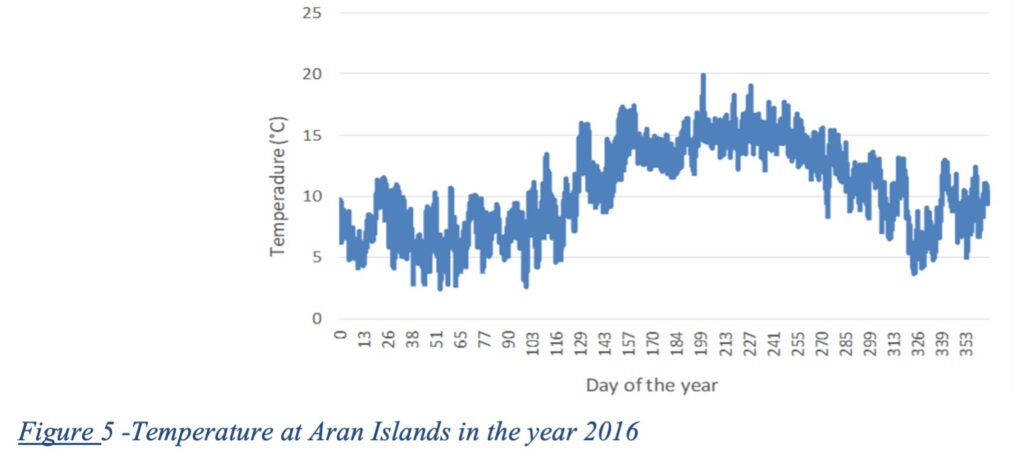
Radiator limits
The maximal thermal power which heating radiators can deliver to the room depends strongly on the supply temperature[2]. Radiators strongly lose their ability to deliver the heat at lower supply temperatures (see Figure 6).
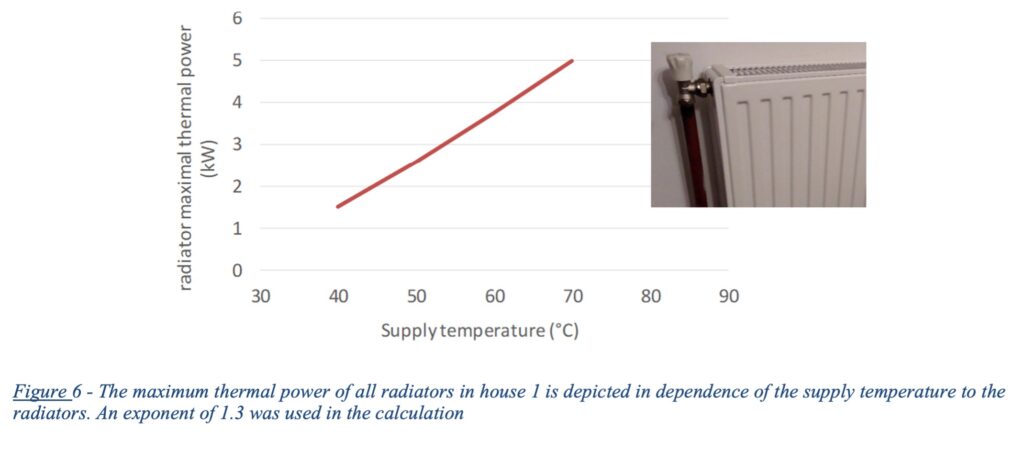
On the other side, the heat pumps get more efficient (higher COP) at lower supply temperatures and have an increased maximal thermal output power.
Smart switching of heat pump modes
Since high supply temperatures lead to low COP values and poor electric efficiency of the air source heat pump, the heat pump control in the simulation can change/optimize the supply temperature for the radiators depending on the heating needs and the power prices in 10 °C steps (40°C, 50°C, 60°C, 70°C) illustrated in Figure 7. Besides heating, the heat pump can also reheat the storage and provide directly hot water.

In Figure 8 the heat supply over the year 2016 is shown including the supply temperatures in different colors. One can see that the supply temperature is frequently adjusted. This is a result of the minimize cost scenario for house 1 (see definition below). The different heating power levels are the radiator limits, at the given supply temperature.
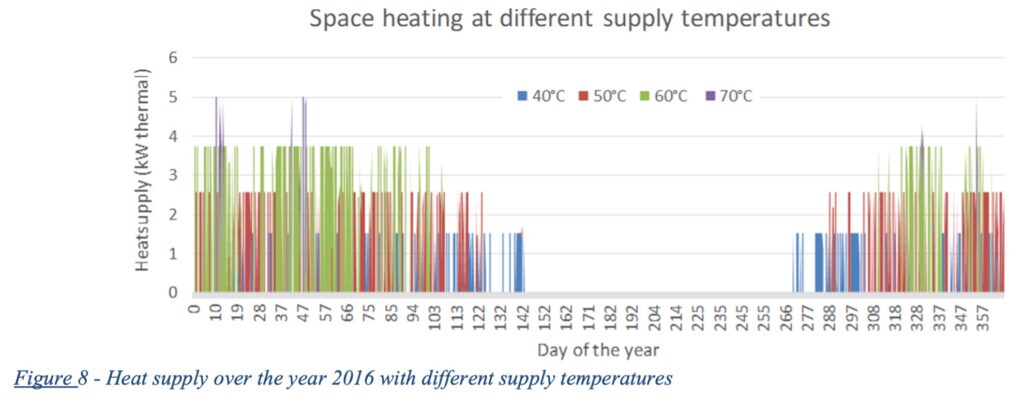
Scenarios for simulation
For the seven buildings on Aran Islands listed in Table 2 below, optimization runs have been conducted. The comparison of two scenarios is used to analyze how much electricity demand flexibility and cost savings can be generated by optimally operating residential buildings equipped with air source heat pumps. As for the steering signal for the heat pumps, we used the spot market price of Ireland.
The scenarios:
- Minimize Cost: The heat pumps are assumed to see the spot market 2016 prices as electricity prices. The model can adapt the heat supply temperatures between 40-70 °C every simulation step. The simulation tries to minimize the electricity costs. The room temperature is limited to be within ±0.5 °C of the setpoint during the heating season. There is no limit on room temperatures in the summer.
- Reference Scenario: Here the model sees only a constant electricity price of 30 EUR/MWh. The heat supply temperature is 60°C constantly over the year. The model tries to reduce electricity consumption. The room temperature is limited to be within ±0.5 °C of the setpoint during the heating season. There is no limit on room temperatures in the summer.
Results
On average over all buildings, the electricity costs are reduced in the “minimized costs” simulation by ‑32% and the electricity demand is -16% lower. This is because in the “minimized costs” simulation the heat pump adjusts the supply temperature to the minimum required and heats preferably when the power prices are low. Whereas, in the “reference scenario” the supply temperature is constantly at 60°C without any sophisticated optimization. About 35% of the load can be shifted on average to leverage lower electricity prices.
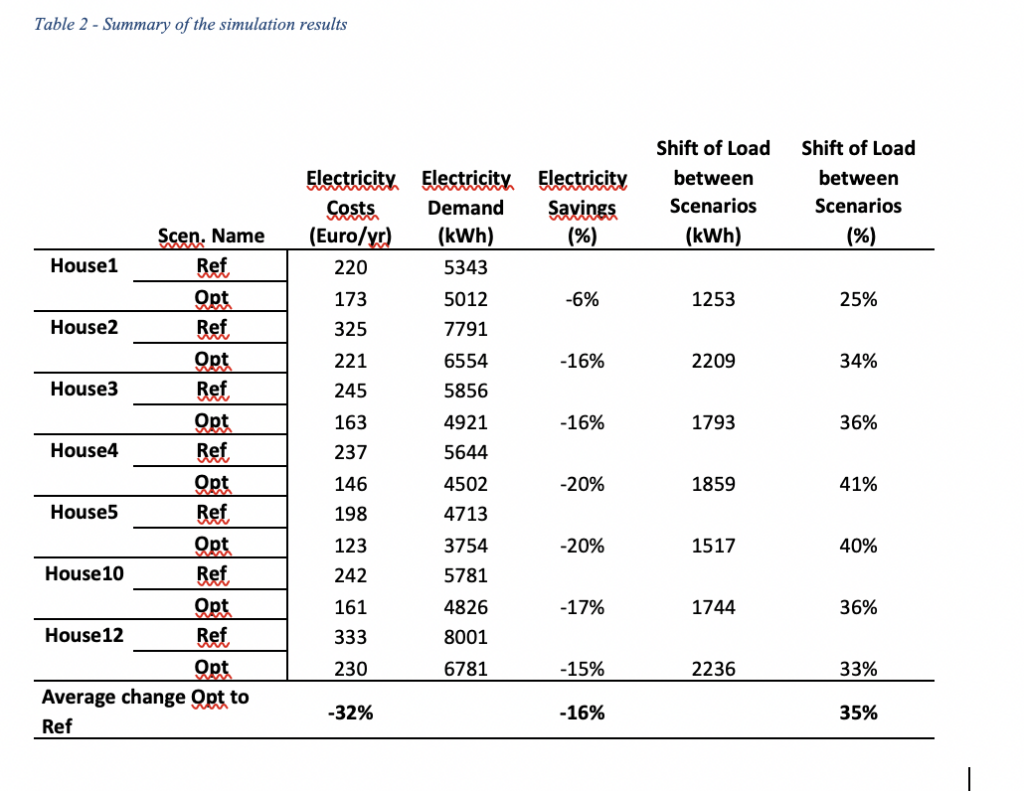
Conclusions
REACT project aims the target of 100% energy autonomy for the islands which means an ambitious uptake of renewable energy sources. Since the renewable heat potentials such as solar thermal and biomethane, are limited in Aran islands, it is estimated that all heat supply from fossil fuels will be replaced by heat pumps. Under the given assumptions for the typical residential buildings with air source heat pumps at Aran Islands on average 35% of the electricity demand could be shifted to optimize the demand according to the electricity prices and to provide flexibility to the power system. By this 32% of the electricity costs could be saved. This can be considered as a win-win situation for customers and the electricity system. Overall, concluding all examinations performed for the Aran Islands, it can be stated that a full decarbonization of the Aran Islands by 2030 can be achieved for the electricity sector, and for the heat sector by using electric heat pumps. The outdoor temperatures in winter are mostly between 5-10°C and are much in favor of air source heat pumps. However, to be able to operate all systems in an economic manner flexible end-user tariffs are needed, so that end-users can react to price signals.
References
[1] H2020 Project REACT Website, REACT 2020 – Renewable Energy for Self-Sustainable Island Communities “. [Online]. Verfügbar unter: https://react2020.eu/. [zugegriffen: 03-Feb-2020].
[2] C. Pleijel, Energy Audit on the Aran Island, Intelligent Energy Europe“, 2015.
[3] Energy Master Plan 2018, Árainn and Inis Meáin“. Fuinneamh Oileáin Árann – Aran Island Energy, 2018.
[4] All Electric Aran Islands Concept. A Design for a Wind and Ocean powered system supplying electricity, Heat and Transport “. Sustainable Energy Authority of Island, 2015.
[5] SEAI, All Electric Aran Islands Concept. A Design for a Wind and Ocean powered system supplying electricity, Heat and Transport, 2015“, SEAI – Sustainable Energy Authority of Island, 2015.
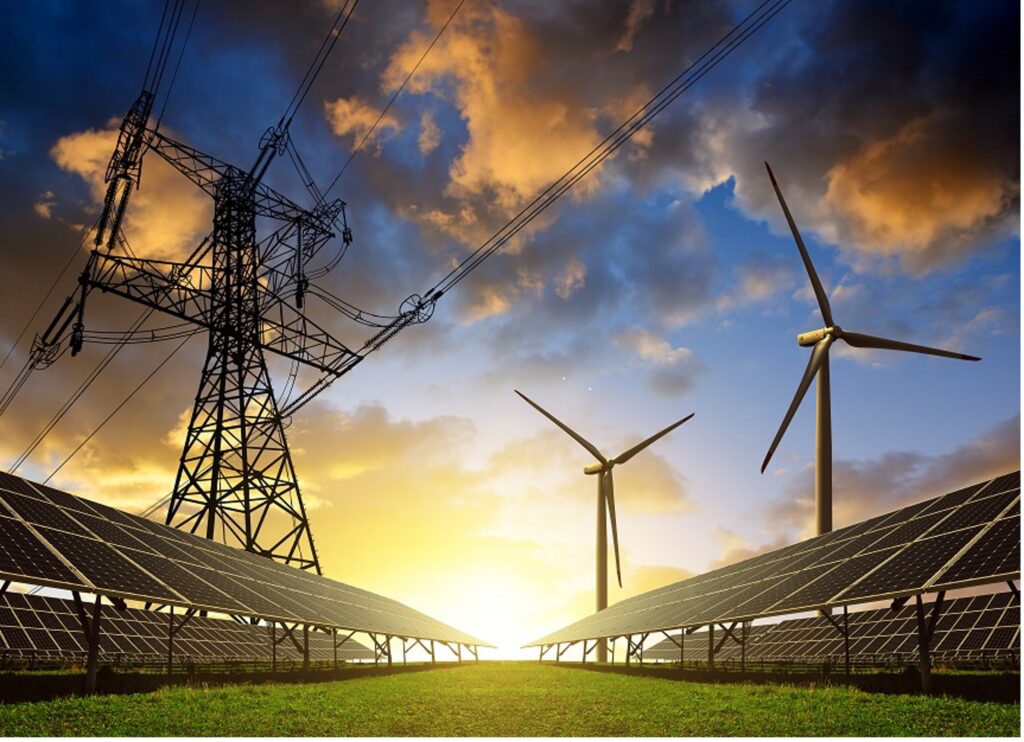
Authors:

DI Dr. Gerhard Totschnig, Research Engineer, AIT Austrian Institute of Technology, Vienna, Austria, gerhard.totschnig@ait.ac.at

DI Dr. Demet Suna, Scientist, AIT Austrian Institute of Technology, Vienna, Austria, demet.suna@ait.ac.at
[1] https://re.jrc.ec.europa.eu/pvg_tools/en/tools.html#HR
[2] http://www.delta-q.de/export/sites/default/de/downloads/heizflaechenauslegung_recknagel.pdf
